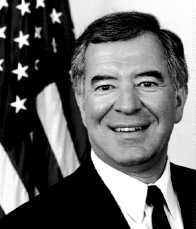

Congressman Nick J. Rayhall II, 33
In 1997, Congress will consider a piece of legislation that perhaps affects the lives of more Americans than any other measure. Yet, this bill will not receive the type of media coverage given the welfare reform legislation passed by Congress or, for that matter, various proposals to reduce taxes.
The reason is that this particular piece of legislation deals with the relatively unglamourous issue of our nation's public works infrastructure and, specifically, our highway system. And that is something of interest to every American who takes to our country's roads. A society's infrastructure, its public works, tells a great deal about the values its people hold dear. Witness the Great Wall of China, built not only as a defensive barrier to the barbarian hordes, but also as a monument to the power of the Ch'in Dynasty.
Or recall the Roman aqueducts, which made city living more bearable, extended the Empire's domination of other societies, and were constructed so well that one is still in use today. And, for that matter, consider the pyramids-the Mayan, the Incan, and the Egyptian-mighty fancy and expensive tombs built to honor human beings deemed to be gods by their subjects.
The growth of America as an industrial power can also be traced by our public works landmarks: from the very first canals and post roads carved out of the wilderness, to the Hoover Dam and the Interstate Highway System. Just as these projects marked our past, they may also shape our future.
I said they may shape our future because, obviously, today a great deal of our public works infrastructure is in great need of repair. For example, look at the condition of our nation's highways and roadways. A full 32 percent of the pavement on America's interstate highways and other major arterial roads is listed as being in poor or mediocre condition.
The question needs to be asked: Will America's interstates last as long as Rome's Appian Way?
The answer may very well lie with the type of legislation Congress considers this year to reauthorize the federal highway program, a bill that will take this program into the next century.

And, over the course of these past 40 years, the major source of federal assistance for the construction and maintenance of these highways, roads, and bridges has been the motor fuel tax which is deposited into the Federal Highway Trust Fund.
Congressman Nick J. Rahall II
While for the short-term, the financing of our basic surface transportation infrastructure program seems relatively secure, I think we all have to question whether we can continue to rely on motor fuel taxes as the primary source of revenue for these projects as we approach the 21st Century.
Federal policy is increasingly favoring mass transit over highway construction. The Clean Air Act and the costs in terms of air quality and to highway congestion are causing many metropolitan areas to devise alternatives to building new roads. Hence, the focus on light-rail and high-speed rail transportation. In Detroit and elsewhere, automobile manufacturers continue to experiment with electric cars and other alternatives to the traditional internal combustion engine.
This means that in the future, if we are to maintain our existing road network, build new highways where needed and provide for expanded transit opportunities, new means of financing must be found.
Experimentation with innovative financing is occurring today. Yet, as it stands right now, the use of loan guarantees and other techniques where federal funds are used for credit enhancement are nowhere near supplanting the direct subsidization of highway projects through Highway Trust Fund apportionments.
The challenge we face, if we are to improve the condition of our existing roads and to construct new highways where necessary, is to foster the development of new revenue streams. This will be the challenge Congress will have to tackle this year when reauthorizing the current highway program.